高中译林牛津英语模块三Unit1教案设计
- 格式:doc
- 大小:94.50 KB
- 文档页数:20
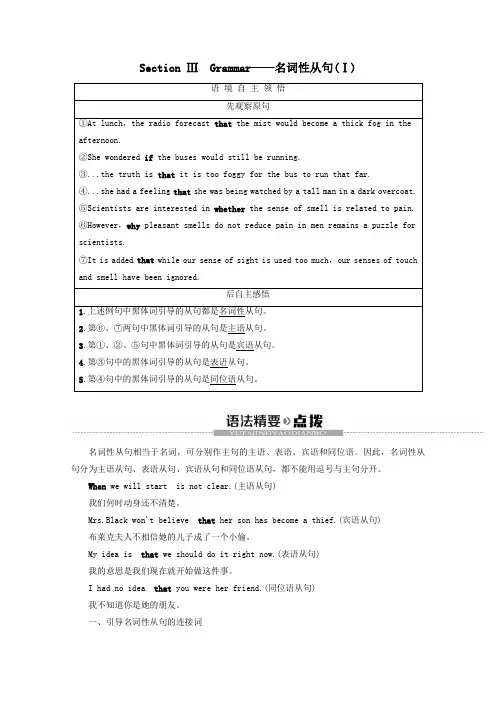
Section ⅢGrammar——名词性从句(Ⅰ)名词性从句相当于名词,可分别作主句的主语、表语、宾语和同位语。
因此,名词性从句分为主语从句、表语从句、宾语从句和同位语从句,都不能用逗号与主句分开。
When we will start is not clear.(主语从句)我们何时动身还不清楚。
Mrs.Black won't believe that her son has become a thief.(宾语从句)布莱克夫人不相信她的儿子成了一个小偷。
My idea is that we should do it right now.(表语从句)我的意思是我们现在就开始做这件事。
I had no idea that you were her friend.(同位语从句)我不知道你是她的朋友。
一、引导名词性从句的连接词二、主语从句1.主语从句是在复合句中充当主语的从句,通常放在主句谓语动词之前或由形式主语it代替,而本身放在句子末尾。
主语从句通常由连词that和whether、连接代词或连接副词引导。
2.that在句中无词义,只起连接作用,在口语和非正式文体中可以省略,但that从句位于句首时,连词that不能省略。
3.连接代词和连接副词在句中既保留自己的疑问含义又起连接作用,在从句中充当成分。
That the football match will be put off is certain now.足球赛将会推迟一事现在已经确定。
Whether he will come or not is still a question.他是否会来仍然是个问题。
Whoever breaks this law deserves a fine.违反该法者应予以罚款。
When the plane is to take off has not been announced.飞机何时起飞还没有宣布。
It is known to all that light travels in straight lines.众所周知,光沿直线传播。
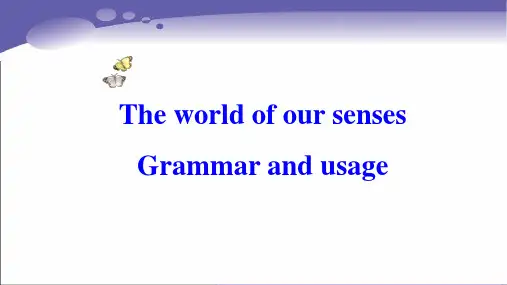
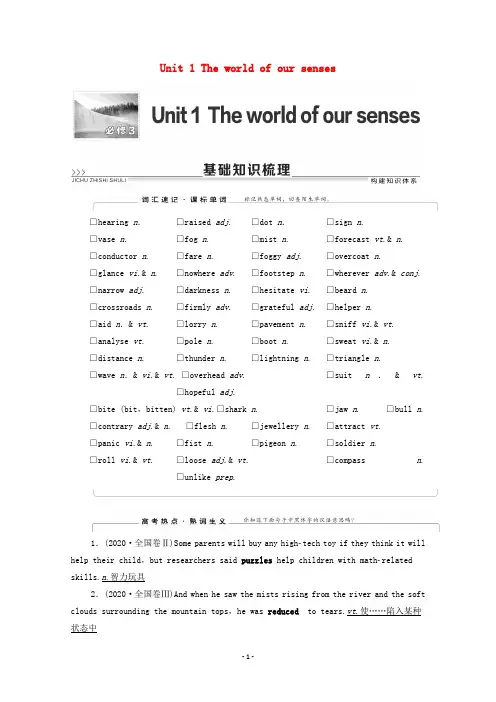
Unit 1 The world of our senses□hearing n.□raised adj. □dot n.□sign n.□vase n. □fog n. □mist n. □fo recast vt.& n.□conductor n. □fare n. □foggy adj. □overcoat n.□glance vi.& n. □nowhere adv. □footstep n. □wherever adv.& conj.□narrow adj. □darkness n. □hesitate vi. □beard n.□crossroads n. □firmly adv. □grate ful adj. □helper n.□aid n.& vt. □lorry n. □pavement n. □sniff vi.& vt.□analyse vt. □pole n. □boot n. □sweat vi.& n.□distance n. □thunder n. □lightning n. □triangle n.□wave n.& vi.& vt. □overhead adv. □suit n.& vt.□hopeful adj.□bite (bit,bitten) vt.& vi.□shark n. □jaw n. □bull n.□contrary adj.& n. □flesh n. □jewellery n. □attract vt.□panic vi.& n. □fist n. □pigeon n. □soldier n.□roll vi.& vt. □loose adj.& vt. □compass n.□unlike prep.1.(2020·全国卷Ⅱ)Some parents will buy any hightech toy if they think it will help their child,but researchers said puzzles help children with mathrelated skills.n.智力玩具2.(2020·全国卷Ⅲ)And when he saw the mists rising from the river and the soft clouds surrounding the mountain tops,he was reduced to tears.vt.使……陷入某种状态中3.(2019·全国卷Ⅰ) Modern methods of tracking polar bear populations have been employed only since the mid1980s,and are expensive to perform consistently over a large area.vt.使用4.(2018·全国卷Ⅰ) Over the years,there have been a number of different techniques to help designers approach this important point.vt.着手处理5.(2018·全国卷Ⅰ) A grasp of how to manage color in your spaces is one of the first steps to creating rooms you'll love to live in.n.理解,掌握6.(2017·北京卷) For example,she received the 2007 BRICK Award recognizing the efforts of young people to change the world.vt.赏识,表彰7.(2016·江苏卷)However,just 12% of disasterrelief funding in the past two decades has gone on reducing risks in advance,rather than recovery and rebuilding afterwards.n.救济;补助[单词拼写·运用]核心单词语境运用1.approach vi.& vt.靠近;着手处理n.靠近;方法;路径2.attach vt.使连在一起,把……附在……上;认为……重要3.volunteer n.志愿者vi.& vt.自愿做,义务做4.likely adj.可能的5.whisper vi.& vt.小声说;私下说6.stare vi.凝视,盯着看7.calm adj.镇静的,沉着的,平静的vt.&vi.使平静,镇静8.puzzle n.谜,疑问vt.迷惑,使困惑9.reduce vt.& vi.减少10.relief n.轻松,宽慰11.tap n.& vt.& vi.轻拍,轻敲12.grasp vt.抓紧,抓牢13.recognize vt.认识,辨认出;意识到;(正式)承认用所给词的适当形式填空。
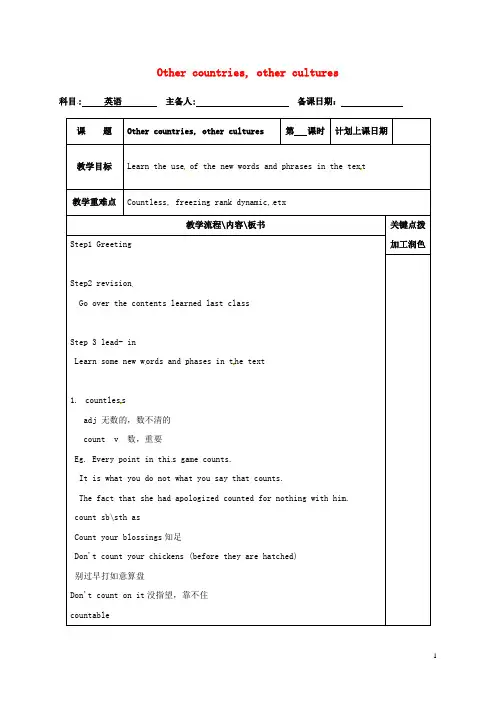
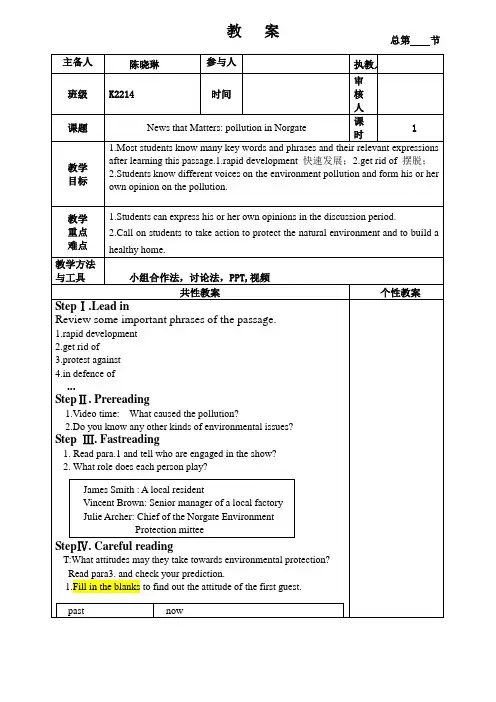
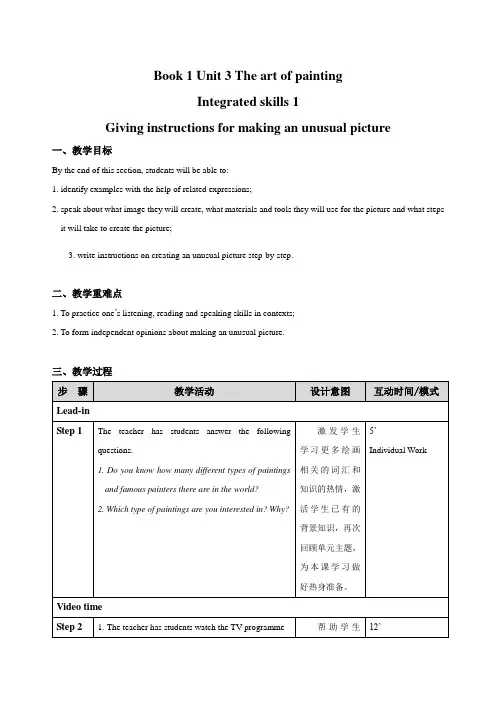
Book 1 Unit 3 The art of paintingIntegrated skills 1Giving instructions for making an unusual picture一、教学目标By the end of this section, students will be able to:1. identify examples with the help of related expressions;2. speak about what image they will create, what materials and tools they will use for the picture and what steps it will take to create the picture;3. write instructions on creating an unusual picture step-by-step.二、教学重难点1. To practice one’s listening, reading and speaking skills in contexts;2. To form independent opinions about making an unusual picture.三、教学过程步骤教学活动设计意图互动时间/模式Lead-inStep 1 The teacher has students answer the following questions.1. Do you know how many different types of paintingsand famous painters there are in the world?2. Which type of paintings are you interested in? Why?激发学生学习更多绘画相关的词汇和知识的热情,激活学生已有的背景知识,再次回顾单元主题,为本课学习做好热身准备。
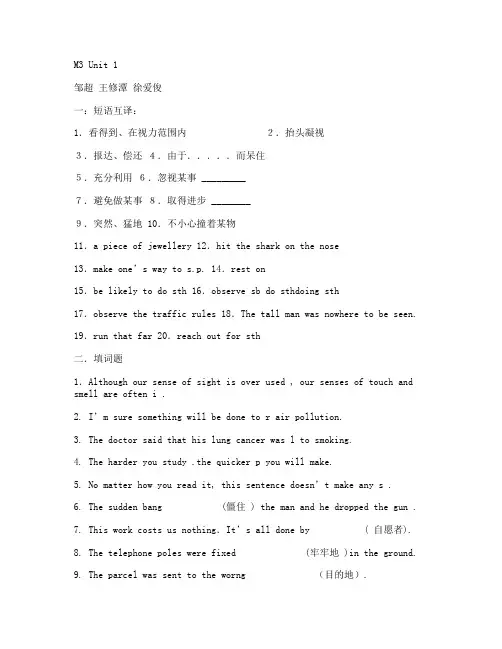
M3 Unit 1邹超王修潭徐爱俊一:短语互译:1.看得到、在视力范围内2.抬头凝视3.报达、偿还4.由于.....而呆住5.充分利用6.忽视某事 _________7.避免做某事8.取得进步 ________9.突然、猛地 10.不小心撞着某物11.a piece of jewellery 12.hit the shark on the nose13.make one’s way to s.p. 14.rest on15.be likely to do sth 16.observe sb do sthdoing sth17.observe the traffic rules 18.The tall man was nowhere to be seen.19.run that far 20.reach out for sth二.填词题1.Although our sense of sight is over used , our senses of touch and smell are often i .2. I’m sure something will be done to r air pollution.3. The doctor said that his lung cancer was l to smoking.4. The harder you study .the quicker p you will make.5. No matter how you read it, this sentence doesn’t make any s .6. The sudden bang (僵住 ) the man and he dropped the gun .7. This work costs us nothing.It’s all done by ( 自愿者).8. The telephone poles were fixed (牢牢地 )in the ground.9. The parcel was sent to the worng (目的地).10 (幸运的, she was in when I called .三:选择题1 My computer ________ work any longer .A won’tB shouldn’tC couldn’tD wouldn’t2 Is it Mr Green _______ runs an organization_______ he wishes formore help for children ?A who, thatB that , whichC who , whereD that , as3 If humans continue to pollute the environment , more serious problemswill _______A result inB result fromC resultD cause4________ explaining to us how to do it , he also did the work together with us .A In addition toB DespiteC In spite ofD Instead of5 You’d better keep the medicine _______ children can’t find it .A in whichB whenC whereD that6 With their work _______ , the workers returned home for supper .A being doneB doneC doD doing7 Americans will never forget the day Sep.11, a sad day , _______ two planescrashed into the World Trade Towers , ______ is always reminding them ofthousands of deaths and ________it happened .A when , which, howB which , that , thatC when , as , whatD that , which , which8 The western development has_______ plenty of jobs .A inventedB developedC discoveredD created9 It was dark everywhere , and the rain _______ our difficulty .A added toB resulted fromC turned outD make up10 It was ________star that you will find it very difficult to notice it .A such little aB such littleC so little aD so a little11 Eventually they found someone who ________ the plane.A took controlB took the control ofC took control ofD had taken the control of12 It is a fact known to all________ everyone has to eat to live .A ThatB whichC of whichD what13 When he decides to do a job , he always finds ______ hard to decide whichjob________A it ,to be doneB that , to doC it , to doD that , he does14 The earthquake made itself _______ as far as in another country .A feelB feelingC feltD to be felt15 It is ______ that people will keep trying to find new ways ______the global warming .A certain , of stoppingB sure , of stoppingC certain , in stoppingD sure ,to stop16_____we were excited about was _______we had won the match .A That , howB That , whetherC What , thatD What , whether17 Everyone else says we should set off earlier . That is _______ I disagree .A whatB whereC whichD why18 People wonder whether things in this country will________ in the near future .A rise upB hold onC pick upD hang out19 My hometown is no longer _______ it was when I was in my teens ,_______seriously polluted .A what , whenB that , whichC what , whichD which , that20 He gained his_______ by printing ________ of famous poets .A wealth ; workB wealths ; worksC wealths ; workD wealth ; works四、完成句子1.他没有时间观念。
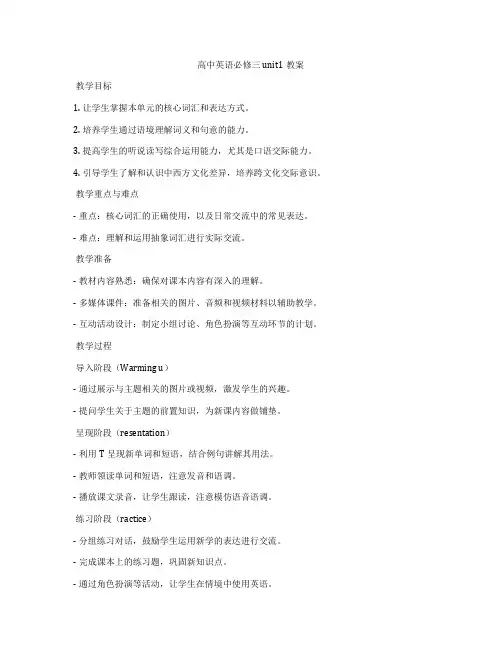
高中英语必修三unit1教案教学目标1. 让学生掌握本单元的核心词汇和表达方式。
2. 培养学生通过语境理解词义和句意的能力。
3. 提高学生的听说读写综合运用能力,尤其是口语交际能力。
4. 引导学生了解和认识中西方文化差异,培养跨文化交际意识。
教学重点与难点- 重点:核心词汇的正确使用,以及日常交流中的常见表达。
- 难点:理解和运用抽象词汇进行实际交流。
教学准备- 教材内容熟悉:确保对课本内容有深入的理解。
- 多媒体课件:准备相关的图片、音频和视频材料以辅助教学。
- 互动活动设计:制定小组讨论、角色扮演等互动环节的计划。
教学过程导入阶段(Warming u)- 通过展示与主题相关的图片或视频,激发学生的兴趣。
- 提问学生关于主题的前置知识,为新课内容做铺垫。
呈现阶段(resentation)- 利用T呈现新单词和短语,结合例句讲解其用法。
- 教师领读单词和短语,注意发音和语调。
- 播放课文录音,让学生跟读,注意模仿语音语调。
练习阶段(ractice)- 分组练习对话,鼓励学生运用新学的表达进行交流。
- 完成课本上的练习题,巩固新知识点。
- 通过角色扮演等活动,让学生在情境中使用英语。
应用阶段(Alication)- 小组讨论相关话题,如文化交流的重要性等。
- 模拟真实场景,如在机场、酒店等情境下的交际对话。
总结与反馈(Summary and feedack)- 总结本节课学习的核心内容。
- 提供反馈,指出学生在学习过程中的优点和需要改进的地方。
作业布置- 背诵本单元的核心词汇和短语。
- 完成一篇关于文化差异的小短文,运用所学知识。
教学反思- 分析本节课的教学效果,记录学生的学习情况。
- 思考如何改进教学方法,提高学生的学习效率。
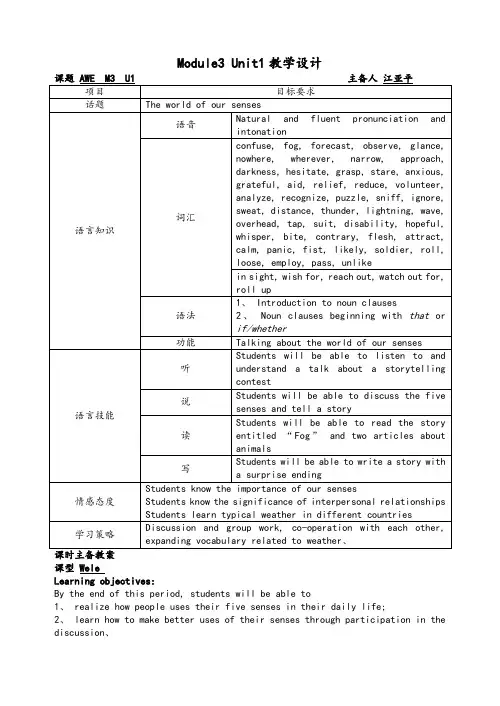
Module3 Unit1教学设计课型 WeleLearning objectives:By the end of this period, students will be able to1、 realize how people uses their five senses in their daily life;2、 learn how to make better uses of their senses through participation in the discussion、Focus of the lesson:1、 picture-talking2、 mastering words about the five sensesPredicted area of difficulties:1、 expressing their opinions about people’s senses2、 memorizing words and phrases concerning five sensesLearning aids:1、2、 blackboardReading (1)Learning objectives:By the end of this period, students will be able to1、 gain an overall understanding of the article;2、 know clearly the important elements of stories;3、 apply what students have learnt in reading strategy part to practical use、Focus of the lesson:1、 having a thorough understanding of the article2、 putting reading strategy into practical useunderstanding the general idea of the articleLearning aids:1、2、 blackboardReading (2)Learning objectives:By the end of this period, students will be able to1、 grasp the usage of some key words and phrases;2、 understand the newspaper article better;3、 use the key words and phrases correctly in relevant exercises、Focus of the lesson:the usage of some key words and phrases1、 the usage of the words and expressions: once, sense, approach, find+O+O、C2、 the usage of thatLearning aids:1、2、 blackboardWord powerLearning objectives:By the end of this period, students will be able to1、 learn that many words in English can have different roles in different types of sentences;2、 review and learn words used to describe different kinds of weatherFocus of the lesson:1、 Parts of speech2、 Words describing the weatherPredicted area of difficulties:Parts of speechLearning aids:1、2、 blackboardGrammar and usageLearning objectives:By the end of this period, students will be able to1、 know clearly what noun clauses are;2、 recognize different kinds of nouns clauses correctly;3、 understand how to use conjunctions that and if/whether to introduce noun clauses、Focus of the lesson:knowing clearly the different types of noun clausesmastering the usage of that and if/whether in noun clausesPredicted area of difficulties:knowing the difference between appositive clauses and attributive clauses Learning aids:1、2、 blackboard____TaskLearning objectives:By the end of this period, students will be able to1、 know clearly how to plot a story;2、 recognize different elements of a ic strip;3、 improve their language in story-telling by using adjectives and adverbs、Focus of the lesson:1、 mastering the rules in plotting a story2、 preparing a story with a surprise endingPredicted area of difficulties:writing a story with a surprise ending using adjectives and adverbsLearning aids:1、2、 blackboardLearning procedures:____ProjectLearning objectives:By the end of this period, students will be able to1、 know how sharks use their senses to survive dangers in their environment and how pigeonscan always find their way home;2、 learn how to talk about animals and their unique senses;3、 develop a TV show about how an animal uses its senses、Focus of the lesson:1、 understanding the main idea of the two articles2、 how to develop a TV showPredicted area of difficulties:developing a TV show about how an animal uses its senses Learning aids:1、2、 blackboard。
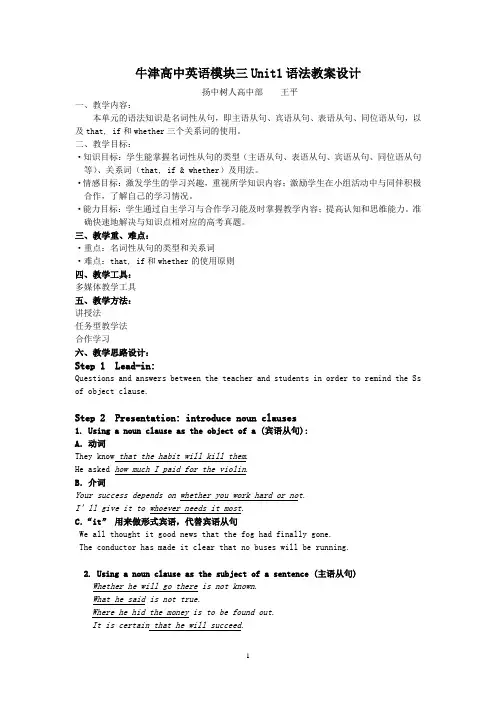
牛津高中英语模块三Unit1语法教案设计扬中树人高中部王平一、教学内容:本单元的语法知识是名词性从句,即主语从句、宾语从句、表语从句、同位语从句,以及that, if和whether三个关系词的使用。
二、教学目标:·知识目标:学生能掌握名词性从句的类型(主语从句、表语从句、宾语从句、同位语从句等)、关系词(that, if & whether)及用法。
·情感目标:激发学生的学习兴趣,重视所学知识内容;激励学生在小组活动中与同伴积极合作,了解自己的学习情况。
·能力目标:学生通过自主学习与合作学习能及时掌握教学内容;提高认知和思维能力。
准确快速地解决与知识点相对应的高考真题。
三、教学重、难点:·重点:名词性从句的类型和关系词·难点:that, if和whether的使用原则四、教学工具:多媒体教学工具五、教学方法:讲授法任务型教学法合作学习六、教学思路设计:Step 1 Lead-in:Questions and answers between the teacher and students in order to remind the Ss of object clause.Step 2 Presentation: introduce noun clauses1. Using a noun clause as the object of a (宾语从句):A.动词They know that the habit will kill them.He asked how much I paid for the violin.B.介词Your success depends on whether you work hard or not.I’ll give it to whoever needs it most.C.“it”用来做形式宾语,代替宾语从句We all thought it good news that the fog had finally gone.The conductor has made it clear that no buses will be running.2. Using a noun clause as the subject of a sentence (主语从句)Whether he will go there is not known.What he said is not true.Where he hid the money is to be found out.It is certain that he will succeed.ing a noun clause as the predictive of be (表语从句)The question is whether we can rely on him.That’s because we were in need of money at that time.He looked as if he was going to cry.That’s why I was late.ing a noun clause in apposition to a noun (同位语从句)The news that he failed in the exam surprised his parents.Word came that we would have two days off next week.There is no possibility that our team will lose the game.I’ll keep the promise that I will help you out when you are in trouble.PracticePlease turn to P 92 and do Exercise C1Step 4 The usage of “that, if & whether”Task1 that在名词性从句中的意义及用法A. that在名词性从句中属于“三无”,即“没有意义,不做成分,一般不省”。
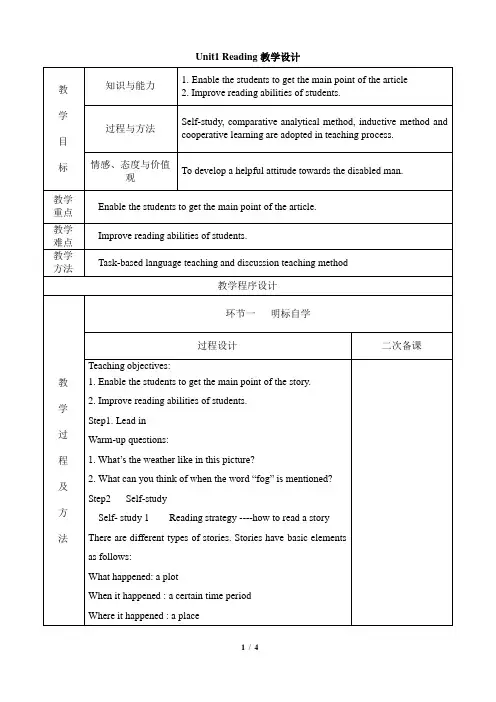
Book 3 Unit 1 Nature in the balance一.单元整体设计思路本单元的主题是“人与自然”,话题是“环境与环境保护”,涉及的语篇类型有:歌曲、记录片脚本、电视访谈节目脚本、小册子等。
本单元的教学旨在帮助学生认识保护环境的重要性,通过学习一些与环境有关的语篇文章,培养学生的环保意识。
本单元涉及到了八个板块。
Welcome to the unit 板块以一首英文歌曲导入主题情境,激发学生对环保话题的兴趣。
Reading板块则以一篇亚马孙雨林的纪录片为参照,引发学生们对环境与人的思考,Grammar则是“环保记录片和环保志愿者活动”,语法以省略这一语法专题为核心。
Integrated skills板块则以“保护动物”创设情境,通过一系列阅读、看、听、说,最终要求学生完成一个呼吁人们保护动物的语篇写作任务。
Extended reading板块以“城市的发展与环境污染”创设情境,旨在引导学生们正视经济发展与环境保护的关系,并培养学生辩证思考的能力。
Project板块要求学生通过合作学习、探究学习完成一个关于环境的小册子。
Assessment板块引导学生就环境问题进行反思,运用本单元所学知识来提升学习能力。
Further study板块引导学生运用资源策略,通过观看与本单元话题相关的纪录片,加强对单元话题的研究。
二.教学内容分析三、单元教学目标1.掌握纪录片脚本的结构及其行文特征。
2.探究归纳省略这一语法现象的规则并在语境中正确运用。
3.完成一篇号召人们保护动物的校报文章。
4.掌握电视访谈节目的语篇特征,学会分辨观点和论点。
5.小组合作,制作关于环境问题的小册子。
四、课时教学安排老师:1.充分备课,了解并解读教材。
2.收集与本单元有关的资料,并做成图片或者音频形式。
3.单词,短语已经重点句型的分析与把握。
4.习题的选用,充分利用现有学习资料。
学生:1.熟悉本单元话题,可以自己查阅有关资料。
Module3 Unitl教学设计课题AWE M3 U1主备人江亚平课时主备教案课型WelcomeLear ning objectives:By the end of this period, stude nts will be able to1. realize how people uses their five sen ses in their daily life;2. l earn how to make better uses of their senses through participation in the discussion. Focus of theless on:1. picture-talk ing2. masteri ng words about the five sen sesPredicted area of difficulties:1. expressing their opinions about people 'senses2. memoriz ing words and phrases concerning five sen ses Lear ning aids:1. PPT2. blackboardLear ning procedures:课型Reading (1)Lear ning objectives:By the end of this period, stude nts will be able to1. gain an overall un dersta nding of the article;2. know clearly the important elements of stories;3. a pply what stude nts have lear nt in readi ng strategy part to practical use. Focus of the less on:1. havi ng a thorough un dersta nding of the article2. putt ing readi ng strategy into practical usePredicted area of difficulties:un dersta nding the gen eral idea of the articleLear ning aids:1. PPT2. blackboardLear ning procedures:课型Reading (2)Lear ning objectives:By the end of this period, stude nts will be able to1. grasp the usage of some key words and phrases;2. un dersta nd the n ewspaper article better;3. use the key words and phrases correctly in releva nt exercises.Focus of the less on:the usage of some key words and phrasesPredicted area of difficulties:1. the usage of the words and expressi ons: on ce, sen se, approach, fin d+O+O.C2. the usage of thatLear ning aids:1. PPT2. blackboardLear ning procedures:课型Word powerLear ning objectives:By the end of this period, stude nts will be able to1. lear n that many words in En glish can have differe nt roles in differe nt types of sentences;2. review and lear n words used to describe differe nt kinds of weatherFocus of the less on:1. Parts of speech2. Words describ ing the weatherPredicted area of difficulties:Parts of speechLear ning aids:1. PPT2. blackboardLear ning procedures:课型Grammar and usageLear ning objectives:By the end of this period, stude nts will be able to1. know clearly what noun clauses are;2. recog nize differe nt kinds of nouns clauses correctly;3. un dersta nd how to use conj un cti ons that and if/whether to in troduce noun clauses. Focus of the less on:knowing clearly the differe nt types of noun clausesmasteri ng the usage of that and if/whether in noun clausesPredicted area of difficulties:knowing the differe nee betwee n appositive clauses and attributive clausesLear ning aids:1. PPT2. blackboardLear ning procedures:课型_____ TaskLear ning objectives:By the end of this period, stude nts will be able to1. know clearly how to plot a story;2. recog nize differe nt eleme nts of a comic strip;3. i mprove their Ian guage in story-telli ng by using adjectives and adverbs. Focus of the less on:1. mastering the rules in plotting a story2. preparing a story with a surprise endingPredicted area of difficulties:writing a story with a surprise ending using adjectives and adverbsLear ning aids:1. PPT2. blackboardLear ning procedures:课型_____ ProjectLear ning objectives:By the end of this period, stude nts will be able to1. know how sharks use their sen ses to survive dan gers in their environment and how pige onscan always find their way home;2. lear n how to talk about ani mals and their unique sen ses;3. develop a TV show about how an ani mal uses its sen ses.Focus of the less on:1. un dersta nding the main idea of the two articles2. how to develop a TV showPredicted area of difficulties:develop ing a TV show about how an ani mal uses its sen sesLear ning aids:1. PPT2. blackboardLear ning procedures:。
单元:Unit 1 The world of our senses板块:Project课堂设计指导思想:本节课是以听、说、读、写为主的project教学课。
本板块的教学以文章阅读为铺垫,重在完成计划、准备、写作,呈现的任务。
而素材的搜集范围,文章的结构,呈现的方式都可以参考阅读的内容。
因此做好阅读疏导和任务安排对最后的成果呈现是否成功有至关重要的作用。
本板块第一教时主要解决文章的理解和疏通,和任务的安排;第二课时需在几天之后进行成果汇报,提倡学生用多种方式,如海报,模拟电视播报,角色扮演小品,记者招待会等。
Teaching aims:1. Get to know something about sharks and pigeons.2. Learn to follow the structure of each passage.3. Group work: Four student s a group. Choose an animal and write a passage about it then produce a TV show.Teaching procedures:Period OneStep 1. Introduction (ppt 4-9)M any animals are of great help to our daily lives or make great contributions to the development of science and technology. Can you list some of the m?Animals are friends of human beings. However, some animals will cause trouble or danger to us in some situations. For example, when they are hungry or when they feel themselves in danger. Do you know some dangerous animals on the land? (Some pictures are shown.) There are also some dangerous animals in the water. (Some pictures are shown.)【设计说明】教师通过两段动物和人的关系的语言和相关图片分别引出本文主角鸽子和鲨鱼。
模块3 unit. 1 Period one 教案Unit 1 The world of our sensesTeaching objectives of the whole unit:1 Develop students’ ability of reading comprehension by reading a story about a blind man who helped others get through a thick fog and the other one about shark attacks, some special senses of animals.2 Develop students’ ability of listening comprehension by listening to two talks about storytelling contest and how to begin the story3 Develop students’speaking ability by discussing how to create their own stories4 Develop students’ writing ability by teaching them how to use proper adjectives and adverbs to make the body of their story more lively, and write a story witha surprising ending5 Develop students’integrated skills of using English by producing a TV show about how an animal uses its senses6 Enlarge students vocabulary about the words to describe the weather7 Help students understand what a noun clause is and noun clauses beginning with that or if/whether1.Welcome to the unitIn this part, students are encouraged to conduct a free discussion about the importance of five senses in their studies and daily life. Students are expected to express their opinions boldly and imaginatively.2.ReadingThe reading text deals with a story about what happened to a young lady on a thick foggy afternoon. The reading strategy of this unit teaches students how to comprehenda story better while reading it. Students will practice identifying these elements.3.Word powerThis section has two parts. In the first part, students will learn that many words in English can have different roles in different types of sentences. In the second part, students will review and learn words used to describe different kinds of weather.4.Grammar and usageThe grammar focus in this unit is on noun clauses. Students are expected to learn what noun clauses are and understand how to use the conjunctions that and if/whether to introduce noun clauses.5.TaskThis section consists of a series of activities which will provide students with opportunities to practice the language skills. And through the three steps, students will learn how to plot a story, prepare a surprise ending and improve their language in storytelling.6.ProjectThe project in this unit is designed to help students learn and use English through doing a project. The purpose of this section is to help students use what they havelearnt to finish a project by working together.7.Self-assessmentThis section aims to help students determine the progress they have made. Period arrangement:Welcome to the unit: 1 periodReading: 3 periodsWord power: 1 periodGrammar and usage: 2 periodsTask: 2 periodsProject: 2 periodsRevision and exercise: 1 periodPeriond 1: welcome to the unitTeaching Aims:---To give the Ss the idea that sometimes the senses affect one another and people may be misled by them. To help them to realize how they use their senses in their studies and daily life and to teach them how to make better use of their senses.--- Ask Ss to fully participate in the discussion, practise their spoken English, and share their opinions with one another.Procedures:Step 1 brainstorming 8 minutes to 10 minutes (Encourage Ss to speak out) Ask the following questions:With what do we see and hear?How do we know that a flower has a pleasant smell?How do we know whether a dish is delicious?What do we do when we want to know whether the water in the basin is hot or cold? How do we know about the world around us?What are the five senses?(Blackboard: See – eyes—sight—lookHear-ears—hearing—soundTaste—tongue—taste—tasteSmell—nose—smell—smellTouch/feel—skin—touch--feel)As we all know almost everyone has five senses. We learn about the world through the five senses and we use them to study, wok and relax. So please tell me the advantages of each sense.…There, however, are some people who have lost one or two of their five senses. What do we address them?Can they still hear, see and feel the world?Are they still useful to our world or can they make contributions to our society? Discuss in groups and then show what your group have found to all of us.…Language studyFill in the blanks with words that have something to do with “senses”:When he got there, he _________ that there was a dark hole. He ________ into it, but could ________ nothing. He ________ with his ears, he could _______ nothing, either. He _________ it for a long time. He _______ something strange. He ___________ the side of the hole. It ______ hot. Suddenly some noises wer e ________ from the hole. It ________ like someone was cooking inside.Possible answers: noticed looked see listened hear watched sense felt/touched felt heard soundedStep 2 sharing information 20’ to 25’ ( to help Ss know more about the 5 senses )Teacher: Do you always believe what you see?Ss:…Teacher: Some say Yes, and some say No. Look at this picture , and tell whether it moves or notTeacher: This time, you may be cheated by your easy!Ask Ss to read the short passage and help them to understand the main ideaAsk them to give more examplesLook at the 4 pictures and answer the questions below.Picture 1Ask Ss what they can see in this picture.Teacher: If you look at the picture in a creative way, you will definitely see a lot more than you don’t.What does the white part look like? How about black part?Ss:…Picture 2Ask Ss how they would find out whether the lines are of the same length. Teacher: You can, of course, use whatever measures do measure the two lines. Ruler or two pieces of paper.Picture 3Have Ss say how they can prove that the two lines are straight.Teacher: Use your ruler next to the line to make sure it is straight if you are not relying on your eye sight.Ss:…Picture 4The symbols in line b can be read as either the letter K, B, R, M, or K, 13, R, M. Teacher: Why are people misled by their own eyes?Ss:…background…it’s more the brain that is confused than the eyes…Step 3 group discussion and interview 5’ to 10’ (to help them build up team spirit)Ask Ss the three questions below.Teacher: There are three questions right below the pictures. Let’s discuss them in groups first, then we will have some news reporters to interview somegroups for each question.Teacher: Time’s up! Stop discussing! It’s our interview time.Homework:1 Spend less than 5 minutes talking to yourself on what you have got in today’sclass in English.2 Translation事实情况是雾太大,车开不了那么远。
牛津高中英语模块三Unit1语法教案设计(word版可编辑修改)编辑整理:尊敬的读者朋友们:这里是精品文档编辑中心,本文档内容是由我和我的同事精心编辑整理后发布的,发布之前我们对文中内容进行仔细校对,但是难免会有疏漏的地方,但是任然希望(牛津高中英语模块三Unit1语法教案设计(word版可编辑修改))的内容能够给您的工作和学习带来便利。
同时也真诚的希望收到您的建议和反馈,这将是我们进步的源泉,前进的动力。
本文可编辑可修改,如果觉得对您有帮助请收藏以便随时查阅,最后祝您生活愉快业绩进步,以下为牛津高中英语模块三Unit1语法教案设计(word版可编辑修改)的全部内容。
牛津高中英语模块三Unit1语法教案设计一、内容分析:本课的教学内容是牛津高中英语模块三Unit1的Grammar and usage板块。
这个板块教授的语法知识是名词性从句,即主语从句、宾语从句、表语从句、同位语从句等主要的从句,以及that, if和whether三个关系词的使用。
由于名词性从句是本单元的教学重点,又是学生新接触的知识点,因此本节课通过课件、教师的讲解与指导和学生的自主与合作学习,力图取得良好的教学效果。
二、对象分析:高一学生已经具备一定的抽象逻辑思维能力,但是名词性从句内容多且复杂,不容易掌握。
因此,部分学生可能会产生抵触或畏难情绪。
本节课将营造轻松愉快的气氛,让学生积极主动地参与到课堂教学中来,实现学生在教学中的主体地位。
三、教学目标:·知识目标:学生能掌握名词性从句的类型(主语从句、表语从句、宾语从句、同位语从句等)、关系词(when, where, who, how, whether, if ,that等)及用法.·情感目标:激发学生的学习兴趣,使他们认真聆听教师的讲解,重视所学知识内容;激励学生在小组活动中与同伴积极合作,了解自己的学习情况。
·能力目标:学生通过所学能完成基础练习并且能写出符合语法规范的名词性从句;通过自主学习与合作学习,学生的自主探究和协作探究能力能有所提高。
Time: Feb.12, 2006 No. 02Topic: Unit 1 ReadingTeaching aims:1.Words, expressions and sentences: truth, deserted, reach out, watch out for2. Enable the Ss tolearn to analyze the story.3. Help the Ss learn reading strategy..Teaching important & difficult points:Learn about the plot of the story.Teaching methods: Discussion and task-based activitiesTeaching aids: A computer and a projectorTeaching procedures & waysStep I Lead-inTalk about the climate or the weather:What’s the weather usually like in spring / summer … here?Which season do you think is the best? Why?Do we sometimes have foggy days here? When?How do you feel on a foggy day?What would you do if you got lost in the fog?Step II Practice1. Go through the passage and try to answer the questions in Part A.2. Read the passage again and complete Parts C1 and C2.3. Fill in the chart.Part Place Time & weather Person(s) What happened Polly’s thought or feelingPart 1 Outside Polly’s work place At 4 p.m. foggy Polly She left work early. She wondered if the bus would still be running.Part 2 At the bus stop in the street Later Polly; the bus conductor The fog was too thick for the bus to run to King Street, where Polly lived.Part 3 In the underground train; at Green Park station Later Polly; a tall man A tall man in the dark coat is on the train. She sensed she was being watched.Part 4 In Park Street;At th ecorner of the street When Polly got to the station, the fog lay like a thik, grey cloud. Polly; a man A rough hand brushed her face. Her heart was beating with fear.Part 5 In the street It was dark. Polly; an old man The old man took her hand and helped her find the way. She wished for someone to come along. Fear held her still. She began to feel frightened again.Part 6 Outside Polly’s house at King Street Late that day Polly; the old blind man The old man left to help more people in need. Polly was thankful.4. Reading strategy.The elements of a storyFocus on what happened, when it happened, where it happened, whyit happened and who was involved in the event5. Retell the story in their own words acording to the route that Polly took home.Outside Polly’s working place → at the bus stop on the street → in theUnderground train → at Green Park station → in Park Street→ at the corner of the street → in the street near King Street→ at 86 King StreetStep III HomeworkList all the language problems.Read the article in Part B in Reading in the Wb.。
Module3 Unit1教学设计
课题AWE M3 U1 主备人江亚平
课时主备教案
课型Welcome
Learning objectives:
By the end of this period, students will be able to
1. realize how people uses their five senses in their daily life;
2. learn how to make better uses of their senses through participation in the discussion.
Focus of the lesson:
1. picture-talking
2. mastering words about the five senses
Predicted area of difficulties:
1. expressing their opinions about people’s senses
2. memorizing words and phrases concerning five senses
Learning aids:
1. PPT
2. blackboard
Learning procedures:
课型Reading (1)
Learning objectives:
By the end of this period, students will be able to
1. gain an overall understanding of the article;
2. know clearly the important elements of stories;
3. apply what students have learnt in reading strategy part to practical use. Focus of the lesson:
1. having a thorough understanding of the article
2. putting reading strategy into practical use
Predicted area of difficulties:
understanding the general idea of the article
Learning aids:
1. PPT
2. blackboard Learning procedures:
课型Reading (2)
Learning objectives:
By the end of this period, students will be able to
1. grasp the usage of some key words and phrases;
2. understand the newspaper article better;
3. use the key words and phrases correctly in relevant exercises.
Focus of the lesson:
the usage of some key words and phrases
Predicted area of difficulties:
1. the usage of the words and expressions: once, sense, approach, find+O+O.C
2. the usage of that
Learning aids:
1. PPT
2. blackboard
Learning procedures:
课型Word power
Learning objectives:
By the end of this period, students will be able to
1. learn that many words in English can have different roles in different types of sentences;
2. review and learn words used to describe different kinds of weather
Focus of the lesson:
1. Parts of speech
2. Words describing the weather
Predicted area of difficulties: Parts of speech
Learning aids:
1. PPT
2. blackboard
Learning procedures:
课型Grammar and usage
Learning objectives:
By the end of this period, students will be able to
1. know clearly what noun clauses are;
2. recognize different kinds of nouns clauses correctly;
3. understand how to use conjunctions that and if/whether to introduce noun clauses.
Focus of the lesson:
knowing clearly the different types of noun clauses
mastering the usage of that and if/whether in noun clauses
Predicted area of difficulties:
knowing the difference between appositive clauses and attributive clauses Learning aids:
1. PPT
2. blackboard
Learning procedures:
课型____Task
Learning objectives:
By the end of this period, students will be able to
1. know clearly how to plot a story;
2. recognize different elements of a comic strip;
3. improve their language in story-telling by using adjectives and adverbs. Focus of the lesson:
1. mastering the rules in plotting a story
2. preparing a story with a surprise ending
Predicted area of difficulties:
writing a story with a surprise ending using adjectives and adverbs Learning aids:
1. PPT
2. blackboard
Learning procedures:
课型____Project
Learning objectives:
By the end of this period, students will be able to
1. know how sharks use their senses to survive dangers in their environment and how pigeons
can always find their way home;
2. learn how to talk about animals and their unique senses;
3. develop a TV show about how an animal uses its senses.
Focus of the lesson:
1. understanding the main idea of the two articles
2. how to develop a TV show
Predicted area of difficulties:
developing a TV show about how an animal uses its senses
Learning aids:
1. PPT
2. blackboard
Learning procedures:。